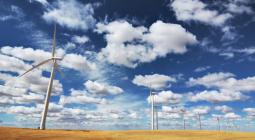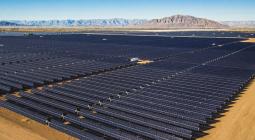BNEF: Onshore wind and solar cheapest new power option for most of planet.

Best land-based renewables on track to dip below benchmark price of $20/MWh 'this side of 2030', says analyst group.
Larger projects and more powerful turbines to meet the pressure of auctions helped onshore wind power to its sharpest cost falls in five years, said BloombergNEF as it predicted the best wind and solar plants will beat $20/MWh before 2030.
Onshore wind power plunged by 9% in six months to a global benchmark levelised costs of energy (LCOE) of $44/MWh, according to the analyst group’s latest half-yearly data. Along with solar, onshore is now the cheapest new-build power option for two-thirds of the world's population, BNEF reckons.
The windiest sites in Brazil using the latest large turbine models are coming in as low as a world-best $24/MWh, helped by lower finance costs there, said BloombergNEF’s latest report on global LCOE. Best onshore wind projects in the US are hitting $26/MWh, with India and Spain as low as $29/MWh, even before subsidies.
The falls seen in early 2020 are the most significant since 2015, said BNEF, helps by the use of bigger turbines that now average 4.1MW at an average price of $700,000 per megawatt. Onshore wind projects have also got bigger, now at an average 73MW compared to 32MW in 2016.
PV cut 4% from its global benchmark LCOE over the last half-year to $50/MWh. The best newly-financed solar projects are coming in at $23-29/MWh in markets including Australia, China, Chile, and the UAE.
Tifenn Brandily, lead author for BNEF, said: “There have been dramatic improvements in the cost-competitiveness of solar and wind. Part of it is due to photovoltaic and wind technology getting better at extracting renewable resources. But our analysis also suggests that since 2016, auctions are forcing developers to realise cost savings by scaling up project size and portfolios.
“Larger scale enables them to slash balance-of-plant, operations and maintenance expenses – and have a stronger negotiating position when ordering equipment.”
Brandily added: “On current trends, the LCOE of best-in-class solar and wind projects will be pushing below $20/MWh this side of 2030.”
Battery storage has also seen dramatic falls, with a benchmark $150/MWh that has halved in two years. Battery is now the cheapest new-build technology for peaking in regions reliant on gas imports, like Europe, China or Japan, BNEF reckons.
The sharp cost reductions, based on data from deals done over the last few months, ensure that solar, wind and storage keep up the pressure on fossil fuel generation, which they are challenging in many markets.
But BNEF and other analysts have warned that the coronavirus pandemic could have changed the game in a matter of weeks, potentially giving fossil sources such as gas or even coal a reprieve.
Seb Henbest, chief economist at BNEF, said: “The coronavirus will have a range of impacts on the relative cost of fossil and renewable electricity. One important question is what happens to the costs of finance over the short and medium term.
“Another concerns commodity prices – coal and gas prices have weakened on world markets. If sustained, this could help shield fossil fuel generation for a while from the cost onslaught from renewables.”
28 April 2020 11:54 GMT





